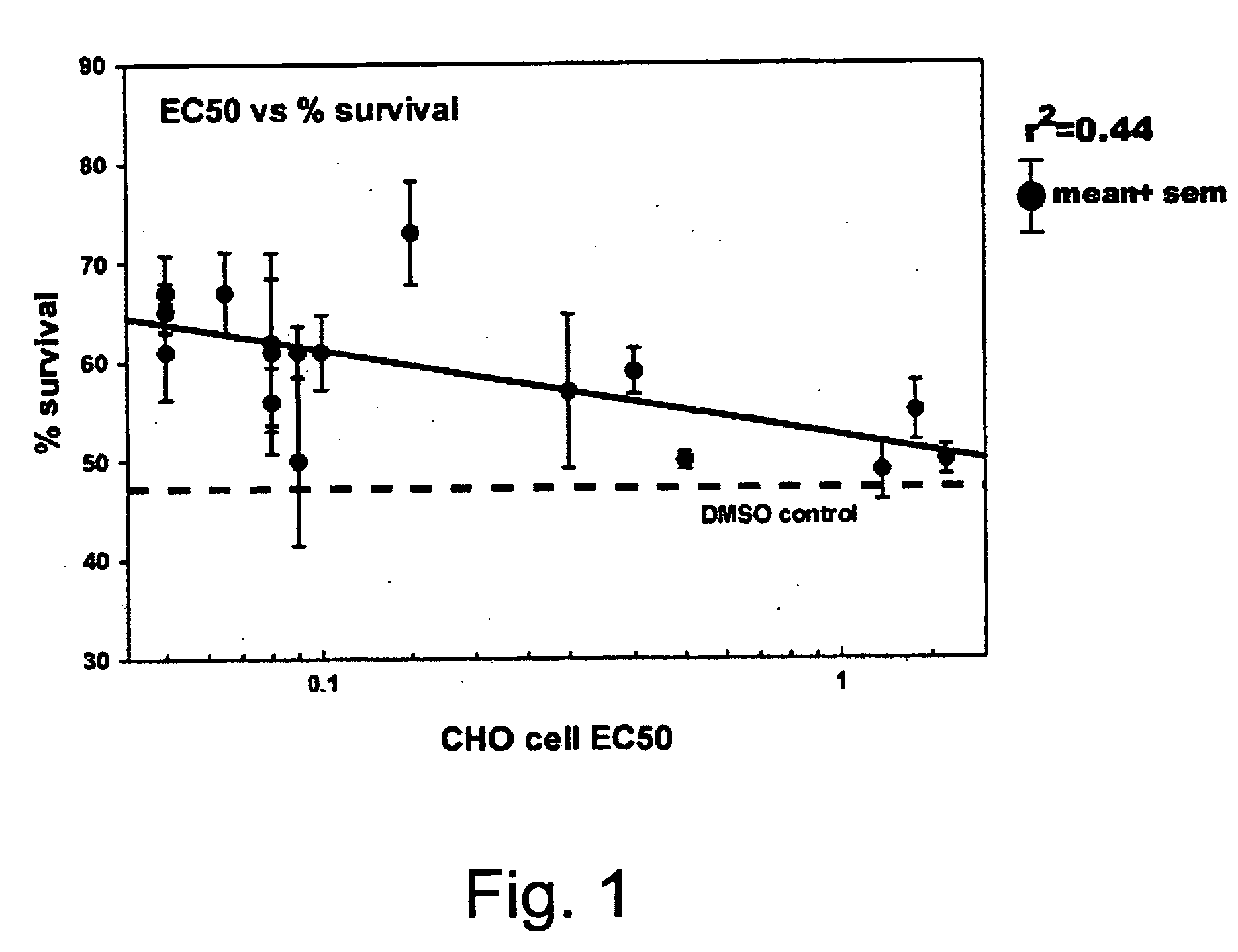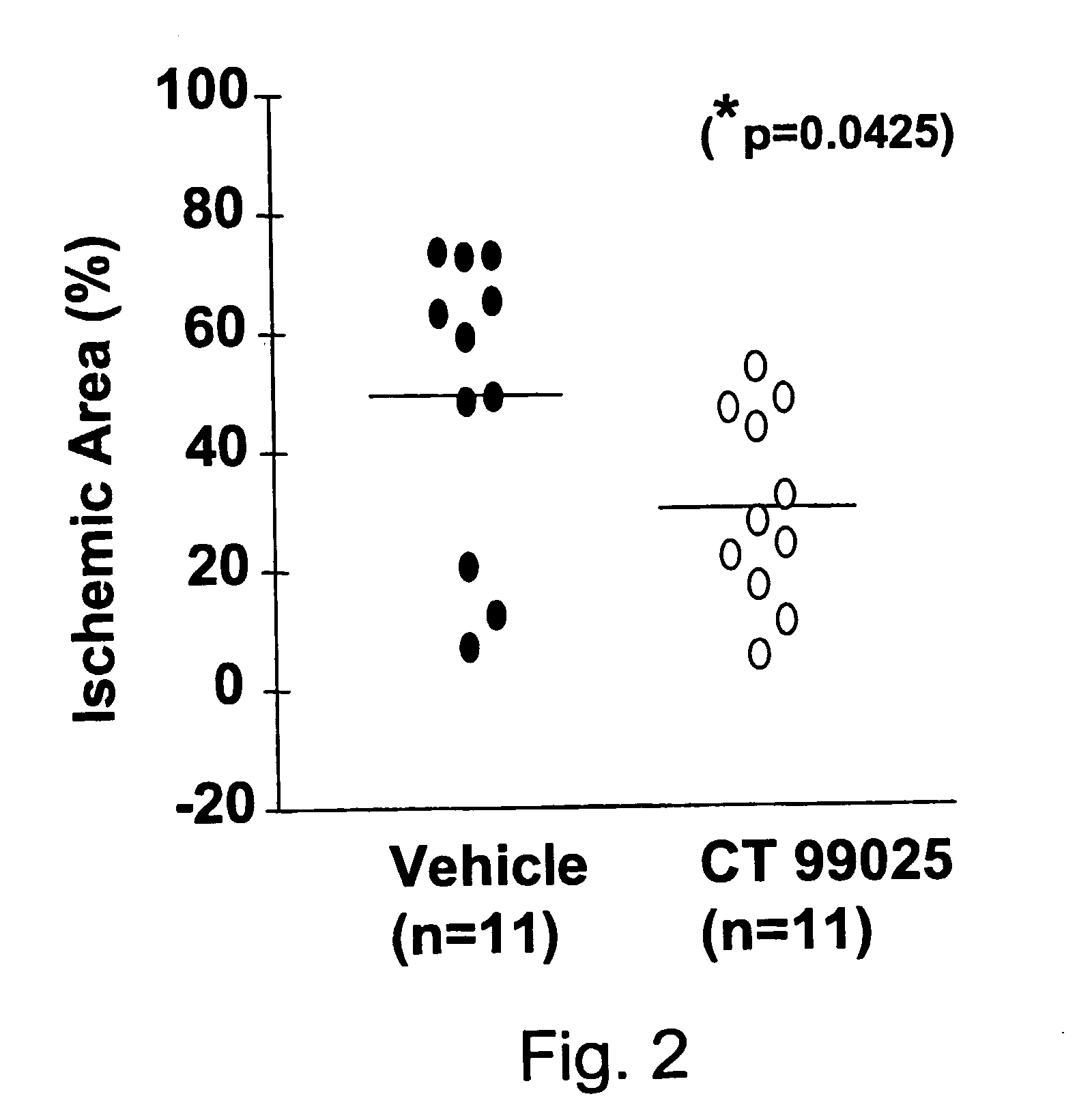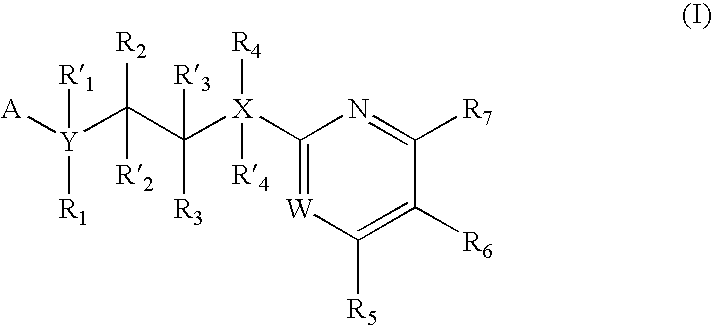Methods and compositions for treatment of ischemia
- Summary
- Abstract
- Description
- Claims
- Application Information
AI Technical Summary
Benefits of technology
Problems solved by technology
Method used
Image
Examples
example
Screening for GSK3 Inhibitory Activity Using a Cell-Based Glycogen Synthase Assay
[0118] CHO-HIRC cells are maintained in 10 cm tissue culture plates in Ham's F12 medium / 10% dialyzed fetal bovine serum. Cells from a confluent 10 cm plate are harvested and divided into the 6 wells of a 6-well tissue culture plate to a final volume of 2 ml of medium. The cells are left to grow at 37° C. for 24 hours. The cells are then washed three times in Ham's F12 medium containing no fetal bovine serum, and finally the cells are left for a further 24 hours at 37° C. in 2 ml of the serum-free medium.
[0119] At the end of this time, 20 μl of compound dissolved in DMSO is added to each well and incubated at 37° C. After 20 minutes the medium is removed and the cells are washed once in PBS at room temperature and then rapidly frozen in the plates in liquid nitrogen. Cells are then thawed on ice in the presence of 140 μl of lysis buffer (50 mM Tris pH 7.8; 1 mM EDTA, 100 mM NaF, 25 μg / ml leupeptin, 1 m...
example 2
GSK3 Inhibitor Protection of Rat Hippocampi Cells From Glutamate Induced Damage
[0122] Hippocampi were dissected from embryonic day 18-19 rats. The tissue was collected in Hibernate™ media (Gibco BRL) and minced into 1 mm pieces. The tissue was dissociated using the Papain Dissociation System (Worthington Biochemical Corporation). Following isolation the cells were suspended in serum-free media composed of Neurobasal™ (Gibco BRL), 2% B27 supplement (Gibco BRL), L-glutamine and antibiotics. Cells were plated in 12 well plates tissue culture dishes coated with poly-L-lysine at a concentration of 7.5×104 cells per well. Following 10-14 days at 37° C. in 5% CO2, the GSK3 inhibitor compounds set forth below were added. Four to eight hours following compound addition, the conditioned media was removed from the cells and the cultures were stored at 37° C. The cultures were rinsed twice with HEPES buffered balanced salt solution (HBSS) containing 10 μM glycine (Grabb and Choi, 1999). The cu...
example 3
Partition Coefficients of Representative GSK3 Inhibitors
[0124] logP is the logarithm of the partition coefficient of the neutral form of a compound between octanol and water. It is a physico-chemical parameter that has a correlation with absorption of small molecules into physiological membranes. The logP of representative GSK3 inhibitor compounds D-Y (Table 1) was determined using the logP prediction program PrologP 5.1 (CompuDrug International, Inc. 705 Grandview Drive, South San Francisco, Calif. 94080 USA). PrologP is an add-on module of the PALLAS system, which serves as a frame of modules predicting physico-chemical features of compounds. The PrologP 5.1 computer program predicts the logP values based on the structural formulas of the compounds. The program uses three different systems for the prediction. These systems disintegrate the compound to fragments, and express the logP value as a superposition of the corresponding fragment constants (Broto et al., Eur. J. Med. Chem....
PUM
| Property | Measurement | Unit |
|---|---|---|
| Time | aaaaa | aaaaa |
| Time | aaaaa | aaaaa |
| Time | aaaaa | aaaaa |
Abstract
Description
Claims
Application Information
 Login to View More
Login to View More - R&D
- Intellectual Property
- Life Sciences
- Materials
- Tech Scout
- Unparalleled Data Quality
- Higher Quality Content
- 60% Fewer Hallucinations
Browse by: Latest US Patents, China's latest patents, Technical Efficacy Thesaurus, Application Domain, Technology Topic, Popular Technical Reports.
© 2025 PatSnap. All rights reserved.Legal|Privacy policy|Modern Slavery Act Transparency Statement|Sitemap|About US| Contact US: help@patsnap.com



